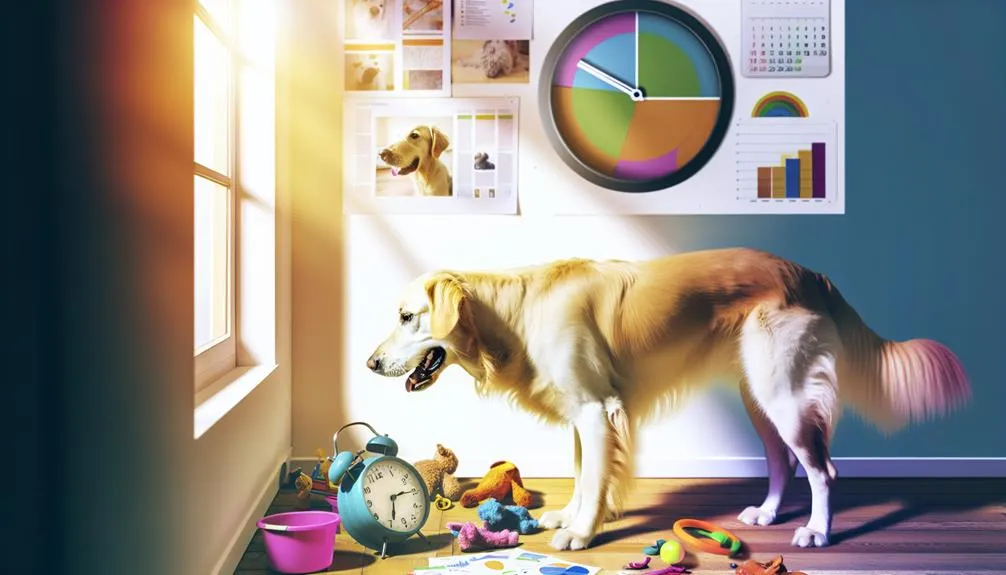
Do Dogs Have a Sense of Time
Did you know that studies suggest dogs can distinguish between 30 minutes and several hours of separation from their owners? This intriguing ability raises questions about how they perceive time. It's not just about the clock; dogs rely on routines and environmental cues to make sense of their world. So, how exactly do these factors shape their understanding of time and influence their behavior? Exploring this topic might reveal surprising insights into the bond you share with your canine companion.
Understanding Time Perception in Dogs
Many dog owners often wonder how their pets perceive time, and it turns out that this question explores fascinating aspects of canine cognition. Dogs have a unique way of understanding time, which isn't necessarily linear like ours. Instead, they seem to rely on cues from their environment, their routines, and their own experiences to estimate time intervals.
Research suggests that dogs may possess a form of time estimation, allowing them to gauge how long their owners have been gone or when it's time for a walk. Their behavioral reactions can provide insights into this ability. For instance, when you return home after a few hours, your dog might greet you with excitement, but if you've only been gone for a few minutes, the reaction may be less intense. This difference indicates that they can differentiate between varying lengths of absence.
Moreover, dogs are highly attuned to changes in their surroundings, such as the position of the sun or the sounds of daily activities, which help them form a sense of time. They might also rely on their internal biological clocks, which regulate their daily routines, leading to anticipatory behaviors like waiting by the door when they expect you to come home.
Understanding how your dog perceives time allows you to better cater to their needs and strengthen your bond. By recognizing their behavioral reactions to different time intervals, you can create a more enriched environment that respects their natural instincts and cognitive abilities.
Routines and Their Impact
Establishing routines can greatly influence how dogs perceive time and relate to their environment. When you set daily schedules, your dog begins to anticipate events based on past experiences. For instance, if you consistently walk your dog at the same time each day, they'll likely start to recognize this pattern, adjusting their behavior accordingly. This anticipation can create a sense of security and predictability in their lives.
Dogs are remarkably adept at picking up on behavioral patterns, often responding to subtle cues that indicate what will happen next. If you feed your dog at a specific time each day, they'll learn to associate your actions—like reaching for the food bowl or grabbing the leash—with feeding time or walk time. This understanding allows them to gauge the passing of time in a way that aligns with their daily routine.
Moreover, a consistent schedule can positively impact a dog's mental well-being. It can reduce anxiety and stress by providing a structured environment where they know what to expect. You might notice that your dog becomes more relaxed and confident when they can rely on you to uphold these routines.
Environmental Cues and Signals

Dogs often rely on environmental cues and signals to navigate their daily lives and understand the passage of time. These cues can range from changes in light and temperature to the sounds that fill their surroundings. For instance, a dog's circadian rhythms, which are influenced by natural light cycles, help them anticipate daily events like walks or meals. When the sun rises or sets, your dog might become more alert, signaling that it's time for their morning routine or evening relaxation.
Additionally, dogs are keen observers of your behavioral patterns. They learn to associate specific activities with certain times of the day. If you typically come home from work at the same hour, your dog may start to pace or wait by the door as that time approaches. This behavior illustrates their ability to recognize patterns and signals in their environment, reinforcing their understanding of temporal concepts.
Moreover, environmental changes, like the sounds of dinner being prepared or the rustling of a leash, can trigger a sense of expectation in your dog. These signals act as cues that help them gauge when certain events will occur. Understanding how dogs interpret these environmental signals can deepen your appreciation for their cognitive abilities and emotional intelligence. It also highlights the strong bond you share, as your dog's responses are shaped by their observations of your routines and the world around them.
The Role of Senses
Understanding how a dog's senses contribute to their perception of time reveals fascinating insights into their cognitive processes. Dogs are equipped with a remarkable olfactory system, allowing them to utilize scent memory as a powerful time marker. When you leave home, your dog may rely on the familiar scents lingering in the environment to gauge how long you've been gone. These scents can serve as temporal anchors, helping them differentiate between a few minutes and several hours based on the strength and freshness of the odors they detect.
Auditory cues also play a significant role in how dogs perceive time. Your dog's acute hearing enables them to pick up sounds that you might overlook, such as the rustle of leaves or the distant hum of traffic. These auditory signals can create a mental timeline, allowing your dog to anticipate your return based on the familiar sounds associated with your arrival, like the sound of your footsteps or the jingle of your keys.
This sensory integration suggests that dogs don't merely rely on a linear concept of time; instead, they interpret temporal experiences through a rich tapestry of scents and sounds. By understanding these mechanisms, you can appreciate the depth of your dog's perception and the emotional nuances that accompany their daily routines. Recognizing their reliance on scent memory and auditory cues not only enhances your bond with your dog but also deepens your understanding of their unique cognitive world.
Scientific Studies on Time Awareness

Research into canine time awareness reveals intriguing findings about how dogs perceive time intervals and their ability to anticipate future events. Studies suggest that dogs possess a form of temporal cognition, allowing them to understand and react to the passage of time. This ability could provide evolutionary advantages, such as enhanced survival skills and social bonding with humans.
In one notable study, researchers examined how dogs responded to different time intervals between their owner's departures and arrivals. The results indicated that dogs could distinguish between short and long separations, suggesting they have an innate sense of time. The following table summarizes key studies on canine time awareness:
| Study | Method | Findings |
|---|---|---|
| S. H. & K. L. (2016) | Owner departures | Dogs reacted considerably more when owners left for 30 minutes compared to 5 minutes. |
| M. T. & A. R. (2018) | Training sessions | Dogs learned to associate specific cues with time intervals, demonstrating temporal understanding. |
| P. F. & L. M. (2020) | Observational | Dogs displayed anticipatory behaviors, such as waiting by the door, indicating awareness of routine. |
These findings highlight not just a fascinating aspect of canine behavior but also emphasize the importance of considering time awareness in our interactions with dogs. Understanding their temporal cognition can deepen your bond, as you recognize their ability to anticipate your actions and routines.
Frequently Asked Questions
Can Dogs Feel Anxious When Routines Change Unexpectedly?
Yes, dogs can certainly feel anxious when routines change unexpectedly. Routine disruptions often trigger separation anxiety, as they rely on familiar patterns for comfort. Understanding their emotional responses can help you provide the support they need.
Do Different Dog Breeds Perceive Time Differently?
Oh sure, your pug's probably got a PhD in time perception! But really, different breeds exhibit unique characteristics, which can influence how they perceive time. It's not just about the tick-tock; it's about their instincts too.
How Does Age Affect a Dog's Sense of Time?
As your dog ages, their memory development changes, impacting age perception. Older dogs may struggle with time intervals, while younger ones often grasp routine better. Understanding these differences helps you cater to their needs effectively.
Can Dogs Remember Past Events Related to Time?
Imagine a clock ticking softly in your dog's mind. Dogs can indeed recall past events, their temporal memory allowing them to associate moments with feelings, leading to emotional responses during event recall that shape their behavior.
Are There Specific Breeds Known for Better Time Awareness?
Certain breeds exhibit enhanced time perception due to their inherent characteristics. For instance, herding breeds often show better awareness of routines, which may indicate stronger time-related skills compared to others. Your dog's breed can influence this capability.
Conclusion
To summarize, while dogs may not perceive time like we do, their unique ability to understand routines and environmental cues shapes their world. It's as if they dance to the rhythm of daily life, anticipating our movements and actions. This deep connection not only enhances their sense of security but also strengthens the bond we share. As you observe your furry friend, remember that time for them is a tapestry woven from experiences, scents, and love.
You may also like
Archives
Calendar
| M | T | W | T | F | S | S |
|---|---|---|---|---|---|---|
| 1 | 2 | 3 | 4 | 5 | 6 | |
| 7 | 8 | 9 | 10 | 11 | 12 | 13 |
| 14 | 15 | 16 | 17 | 18 | 19 | 20 |
| 21 | 22 | 23 | 24 | 25 | 26 | 27 |
| 28 | 29 | 30 | ||||
Leave a Reply